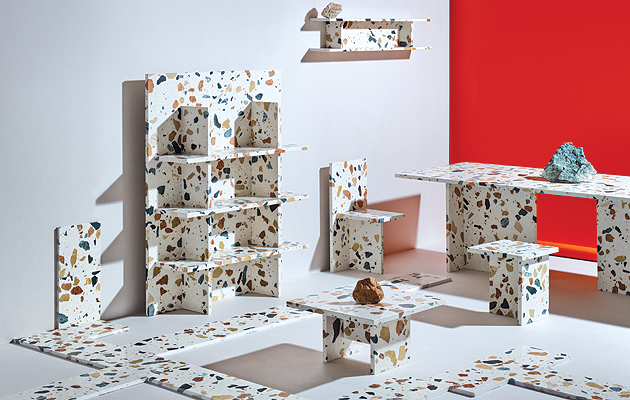|
The British designer’s furniture series for Dzek showcases his own engineered stone – a nougat-like composition of four types of Italian marble
How did you come to work on the project?
During some time spent in Yorkshire, I discovered a traditional terrazzo manufacturer called Toffolo, founded in 1916 and of Italian descent. I spent a day with the current owner to learn about the process of laying terrazzo. After some time I developed an idea for making a tile using large pieces of stone as the bulk of the mix to emphasise the stoniness of man-made stone, rather than the usual small pieces of aggregate typical to terrazzo.
How is Marmoreal made?
Boulders of different types of marble, mostly waste from the quarrying industry, are crushed and graded into different sizes, then weighed and combined in a large industrial mixer with 5 per cent polyester resin. The ten tonnes of mix is emptied into a rectangular mould and compressed into a block measuring 3m x 1.2m x 0.8m. I selected four types of Italian marble; Rosso Sant Ambrogio, Giallo Mori, Verdi Alpi and Bianco Verona (Biancone).
What was it like to work with a man-made material?
Ninety-five per cent of Marmoreal is natural marble, and although the recipe has been designed by me, nature takes full control of the random yet ordered composition of the stone. I honestly don’t see working with an agglomerate stone as any different to working with natural stone, or wood, or bronze, or even polystyrene; they are all raw materials. The difference with Marmoreal is that I designed it.
Tell us about the furniture you’ve made with the material.
Marmoreal is all about the material – cutting a block of stone into thin slabs and tiles makes the most of the beauty within the block – so I designed furniture pieces that best celebrate the surface of the material. A library, bookshelf, dining table, chair, stool and low table are all fabricated from standard slabs of the material that combine to maximise the amount of surface visible.
What else will you be showing in Milan?
I was invited by Kvadrat to design a new piece of work using its Divina fabric from 1984. Noticing the soft felted, non-fraying properties of the fabric, I redesigned an item of work-wear known as a smock, traditionally worn by Cornish fishermen.
Project B Gallery, Via Maroncelli 7
|

















